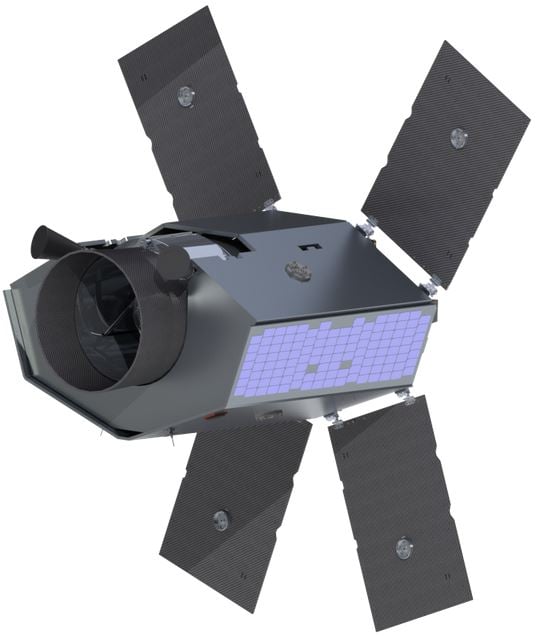Twinkle is a planned satellite that will seek out Earth-like and other types of exoplanets, examining their atmospheres and providing scientists with new insights into their formation, chemistry and evolution, says a team of scientists from University College London (UCL).
The satellite will be launched within the next four years, and the mission will be led by UCL and Surrey Satellite Technology Ltd., a University of Surrey spin-off company that is now fully owned by satellite maker EADS Astrium.
Lead scientist, Prof Giovanna Tinetti of UCL, said:
“Twinkle is a very ambitious mission. Nearly two thousand exoplanets – planets orbiting stars other than our Sun – have been discovered to date, but we know very little about these alien worlds. We can measure their mass, density and distance from their star.”

Rendering of the Twinkle mission spacecraft, which will be built by Surrey Satellite Technology Ltd. (Image: Twinkle Mission)
“From that, we can deduce that that some are freezing cold, some are so hot that they have molten surfaces, some are vast balls of gas, like Jupiter, or small and rocky, like Earth. But beyond that, we just don’t know…”
“Twinkle will be the first mission dedicated to analysing exoplanets atmospheres, and will give us a completely new picture of what these worlds are really like.”
When exoplanets pass in front of the star they are orbiting, a small quantity of starlight is filtered through the clouds and molecules in their atmosphere.
Twinkle will measure this light and be able to pick out the characteristic spectral hallmarks (fingerprints) that tell us whether such gases as methane or water vapour are present.
Atmospheric data reveal a lot about a planet
Prof. Tinetti played a pivotal role in the team that initiated this technique through observations with the Hubble and Spitzer Space Telescopes. Finding out what an exoplanet’s atmosphere consists of helps scientists determine whether it was born in its current orbit or migrated from a different part of its planetary system.
The chemistry, evolution, physical processes and make-up driving a distant planet’s atmosphere are significantly affected by how far it is from its parent star. The atmospheres of small, Earth-like planets could have evolved quite dramatically from their initial composition.
The loss of lighter molecules, impacts with asteroids, comets or other bodies, volcanic activity, or even life, can considerably change the composition of primordial atmospheres.
The atmospheric conditions of a planet can tell us two things: 1. Its history. 2. Whether it might be suitable to host life, or be habitable.
Over 100 exoplanets to be observed
The team plans to use Twinkle to analyze more than 100 exoplanets in our Galaxy (the Milky Way).
Twinkle’s infrared spectrograph will enable astronomers to observe several planet types including super-Earths (rocky planets 1 to 10 times the mass of Earth) and hot-Jupiters (gas giants in very close orbits to their suns).
While some of the planets Twinkle will observe orbit stars similar to our Sun, others orbit cooler red-dwarfs (smaller, older stars). For the biggest planets orbiting bright stars, the satellite will even be able to produce maps of clouds and temperature.
Prof. Tinetti said:
“The light filtered through the planet’s atmosphere is only about one ten thousandth of the overall light from the star. That’s a big challenge and one that requires a very stable platform outside the screening effects of Earth’s atmosphere.”
Surrey Satellite Technology Ltd. (SSTL) will build the spacecraft, while UCL will construct Twinkle’s scientific instruments.
Dr. Susan Jason, SSTL’s lead engineer, said:
“This is an exciting opportunity to adapt the high-performance capacity we have developed at SSTL to deliver ground-breaking science.”
Twinkle, which will be built to operate for at least three years, will be launched into a polar low-Earth orbit.
Twinkle will be much cheaper than equivalent projects
The mission, which is expected to cost about ₤50 million ($76 million), will be funded through a combination of private and public sources.
According to UCL and SSTL, Twinkle will cost about one tenth to build and operate compared to other equivalent astrophysical spacecraft developed through the international space agency programmes.
Prof. Jonathan Tennyson, senior advisor for the Twinkle mission, said:
“The UK has already made an outstanding contribution to exoplanet detection with the WASP survey programme. Twinkle is a unique chance for the UK to build on this and take the world lead in understanding exoplanet science, as well as to inspire the next generation of scientists and engineers.”
Video – Venus transit across the disc of the Sun
This NASA Solar Dynamics Observatory footage shows the transit of Venus across the disc of the Sun. Twinkle will detect light filtered through the exoplanets’ atmospheres as they transit stars in distant solar systems. It will decode the data about their atmospheric chemistry, formation and evolution.

